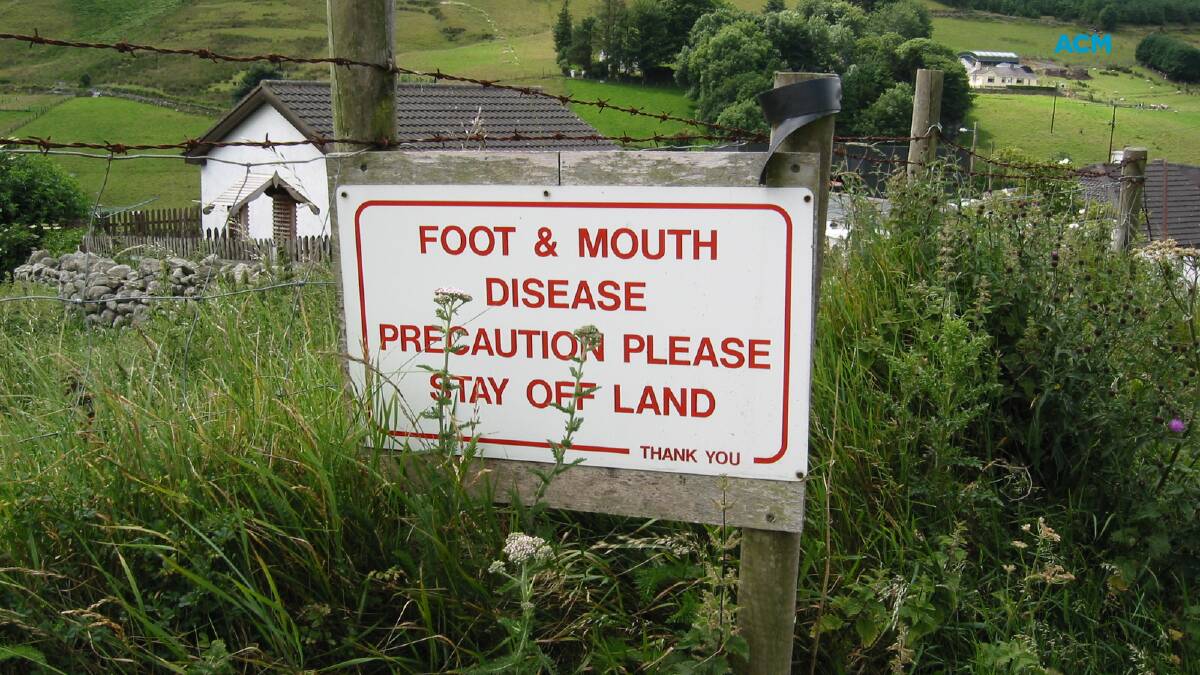Australia's biosecurity officials and cattle industry is on high alert after foot-and-mouth (FMD) disease was recorded in Indonesia and viral fragments were detected in Melbourne.
FMD is considered one of Australia's biggest biosecurity risks, with the Department of Agriculture, Water and the Environment (DAWE) estimating a small FMD outbreak, controlled in three months, could cost around $7.1 billion, while a large 12-month outbreak would cost $16 billion.
DAWE said the 2001 outbreak in the United Kingdom caused losses of more than 8 billion pounds (approximately $AUD 19 billion).
But it isn't just the production losses that are of concern. The most significant impact of the disease occurs because of its effect on trade in livestock and livestock products.
Countries without the disease, which include many of Australia's major trading partners, do not import from, or severely restrict imports from FMD-infected countries, which means an outbreak would have serious economic implications.
What is foot-and-mouth disease?
FMD is a highly contagious virus disease of animals. It is one of the most serious livestock diseases. It affects cloven-hoofed animals (those with divided hoofs), including cattle, buffalo, camels, sheep, goats, deer and pigs.

While it can cause serious production losses the most significant impact of the disease occurs because of its effect on trade in livestock and livestock products.
There are seven serotypes of the virus: A, O, C, SAT1, SAT2, SAT3 and Asia1. These are further subdivided into more than 60 strains. The importance of these serotypes is that protection against one serotype (e.g. through vaccination) will not protect against infection with another serotype. Different serotypes dominate in different parts of the world.
How is it transmitted?
FMD virus is excreted in breath, saliva, mucus, milk and faeces and can be excreted for up to four days before clinical signs appear. It can also be spread on wool, hair, grass or straw; by the wind; or by mud or manure sticking to footwear, clothing, livestock equipment or vehicle tyres.
Animals can become infected through inhalation, ingestion and direct contact, with the disease spreading most commonly through the movement of infected animals.
In sheep the symptoms can be absent or mild, and undetected infected sheep can be an important source of infection.
Pigs are regarded as 'amplifying hosts' because they can excrete large quantities of the virus in their exhaled breath.
Cattle can be infected by breathing in small quantities of the virus. In some animals ('carriers'), the virus can continue to be carried for long periods (months or years) after apparent recovery.
How does it affect animals?
While FMD isn't often lethal in adult animals, it can kill young animals and cause serious production losses.
The clinical signs are fever followed by the appearance of vesicles (fluid-filled blisters) between the toes and on the heels, on mammary glands and especially on the lips, tongue and palate. These vesicles often combine to form large, swollen blisters that erupt to leave raw, painful ulcers that take up to 10 days to heal.
Foot lesions leave animals lame and unable to walk to feed or water. Tongue and mouth lesions are painful and cause animals to drool and stop eating. Adult livestock usually begin eating again after a few days, but the young may weaken and die, or be left with foot deformities or damage to the mammary glands.
Signs to look out for:
- lameness
- long strings of sticky saliva (cattle)/drooling
- blisters on the mouth, snout, tongue, lips or between and above the hooves on the feet; blisters may be intact or ruptured, exposing raw, painful tissue.
Is there any treatment or cure?
No. Affected animals will recover. Vaccines can protect against the disease but do not necessarily prevent livestock from being infected. Vaccination is used in many countries to control the disease in an endemic situation.
In order for a country to regain FMD-free status and limit the economic impacts, it is important to eradicate the virus as quickly as possible.
READ MORE:
Movement controls and removal of infected animals (along with other complementary control measures such as cleaning and disinfection) are essential to eradicate this disease.
Vaccination can be an important tool to assist in containing and eradicating FMD, but its use will have trade implications.
What would happen if an outbreak occurred in Australia?
Australia's response plans call for the rapid detection, diagnosis and eradication. Eradication would involve detection of infected animals and their humane slaughter and biosecure disposal.
The carcases and any contaminated products would be buried or burnt. Trials are currently being undertaken to investigate the possibility of composting carcases and contaminated products.
If you notice any unusual disease signs, abnormal behaviour or unexplained deaths in your livestock, contact your veterinarian, stock inspector, local Department of Primary Industries/Agriculture, or the Emergency Animal Disease Watch Hotline on 1800 675 888.
Does FMD affect humans?
Human infections have been reported but they are rare and do not result in serious disease. Humans can carry the virus in their nose for up to 24 hours and can be a source of infection for animals.
The human hand, foot-and-mouth disease (HFMD) is different to FMD and is caused by a different organism. Viruses from the group called enteroviruses cause HFMD.


